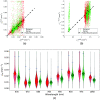Evaluation of a pipeline for simulation, reconstruction, and classification in ultrasound-aided diffuse optical tomography of breast tumors
- PMID: 35332743
- PMCID: PMC8943242
- DOI: 10.1117/1.JBO.27.3.036003
Evaluation of a pipeline for simulation, reconstruction, and classification in ultrasound-aided diffuse optical tomography of breast tumors
Abstract
Significance: Diffuse optical tomography is an ill-posed problem. Combination with ultrasound can improve the results of diffuse optical tomography applied to the diagnosis of breast cancer and allow for classification of lesions.
Aim: To provide a simulation pipeline for the assessment of reconstruction and classification methods for diffuse optical tomography with concurrent ultrasound information.
Approach: A set of breast digital phantoms with benign and malignant lesions was simulated building on the software VICTRE. Acoustic and optical properties were assigned to the phantoms for the generation of B-mode images and optical data. A reconstruction algorithm based on a two-region nonlinear fitting and incorporating the ultrasound information was tested. Machine learning classification methods were applied to the reconstructed values to discriminate lesions into benign and malignant after reconstruction.
Results: The approach allowed us to generate realistic US and optical data and to test a two-region reconstruction method for a large number of realistic simulations. When information is extracted from ultrasound images, at least 75% of lesions are correctly classified. With ideal two-region separation, the accuracy is higher than 80%.
Conclusions: A pipeline for the generation of realistic ultrasound and diffuse optics data was implemented. Machine learning methods applied to a optical reconstruction with a nonlinear optical model and morphological information permit to discriminate malignant lesions from benign ones.
Keywords: breast cancer; breast digital phantom; diffuse optical tomography; lesion classification; ultrasound.
Figures








Similar articles
-
Two-stage classification strategy for breast cancer diagnosis using ultrasound-guided diffuse optical tomography and deep learning.J Biomed Opt. 2023 Aug;28(8):086002. doi: 10.1117/1.JBO.28.8.086002. Epub 2023 Aug 26. J Biomed Opt. 2023. PMID: 37638108 Free PMC article.
-
Diffuse optical tomography reconstruction method using ultrasound images as prior for regularization matrix.J Biomed Opt. 2017 Feb 1;22(2):26002. doi: 10.1117/1.JBO.22.2.026002. J Biomed Opt. 2017. PMID: 28152129 Free PMC article.
-
Diffuse optical tomography using semiautomated coregistered ultrasound measurements.J Biomed Opt. 2017 Dec;22(12):1-12. doi: 10.1117/1.JBO.22.12.121610. J Biomed Opt. 2017. PMID: 29260537 Free PMC article.
-
A review of optical breast imaging: Multi-modality systems for breast cancer diagnosis.Eur J Radiol. 2020 Aug;129:109067. doi: 10.1016/j.ejrad.2020.109067. Epub 2020 May 18. Eur J Radiol. 2020. PMID: 32497943 Free PMC article. Review.
-
Optical tomography with ultrasound localization for breast cancer diagnosis and treatment monitoring.Surg Oncol Clin N Am. 2007 Apr;16(2):307-21. doi: 10.1016/j.soc.2007.03.008. Surg Oncol Clin N Am. 2007. PMID: 17560514 Free PMC article. Review.
Cited by
-
Two-stage classification strategy for breast cancer diagnosis using ultrasound-guided diffuse optical tomography and deep learning.J Biomed Opt. 2023 Aug;28(8):086002. doi: 10.1117/1.JBO.28.8.086002. Epub 2023 Aug 26. J Biomed Opt. 2023. PMID: 37638108 Free PMC article.
-
Acousto-Optics: Recent Studies and Medical Applications.Biosensors (Basel). 2023 Jan 25;13(2):186. doi: 10.3390/bios13020186. Biosensors (Basel). 2023. PMID: 36831952 Free PMC article. Review.
-
Automated pipeline for breast cancer diagnosis using US assisted diffuse optical tomography.Biomed Opt Express. 2023 Nov 1;14(11):6072-6087. doi: 10.1364/BOE.502244. eCollection 2023 Nov 1. Biomed Opt Express. 2023. PMID: 38021111 Free PMC article.
-
Real-time breast lesion classification combining diffuse optical tomography frequency domain data and BI-RADS assessment.J Biophotonics. 2024 May;17(5):e202300483. doi: 10.1002/jbio.202300483. Epub 2024 Mar 2. J Biophotonics. 2024. PMID: 38430216 Free PMC article.
References
-
- Yodh A., Chance B., “Spectroscopy and imaging with diffusing light,” Phys. Today, 48, 34–41 (1995).PHTOAD10.1063/1.881445 - DOI
-
- Boas D. A., et al. , “Imaging the body with diffuse optical tomography,” IEEE Signal Process. Mag. 18(6), 57–75 (2001).ISPRE610.1109/79.962278 - DOI
-
- Pifferi A., et al. , “SOLUS: an innovative multimodal imaging system to improve breast cancer diagnosis through diffuse optics and ultrasounds,” Proc. SPIE 11639, 116390C (2021).PSISDG10.1117/12.2576778 - DOI
Publication types
MeSH terms
LinkOut - more resources
Full Text Sources
Other Literature Sources
Medical

